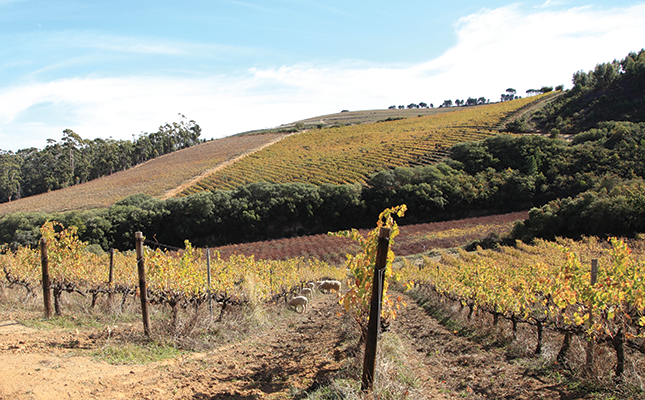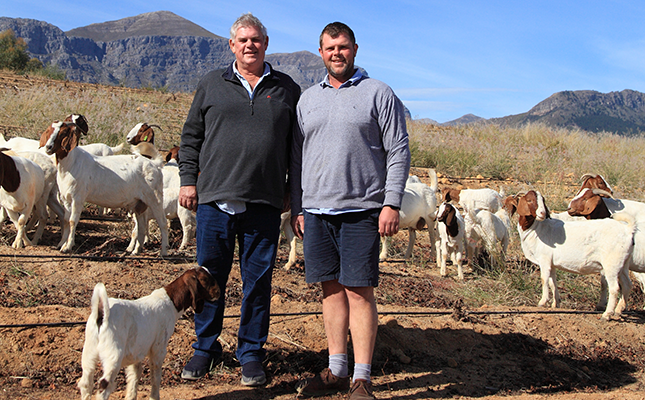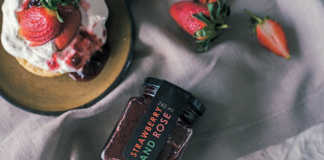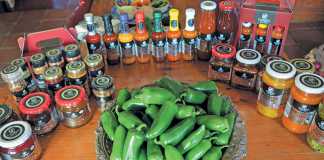
Photo: Glenneis Kriel
Sustainability, it is clear, has always been a priority for the Bosmans: no fewer than eight generations of this family have farmed on Lelienfontein near Wellington in the Western Cape.
Over the past five years, in their latest endeavour to leave the land better for future generations, the Bosmans have switched to organic production in a number of their vineyards. In all, 20ha are under organic certification with Ecocert, and 30ha are being converted to organic farming.
According to Jannie Bosman, current chairperson of Bosman Adama, the international market for organic wines has grown steadily over the past few years, driven by consumers’ demand for wines that are free of additives and produced in an environmentally responsible way.

Consumers are also willing to pay a premium for these wines, while competition in this sales category is less fierce than for conventional wines.
Despite all these advantages, organic wine production is not yet as lucrative as conventional production, a fact that Jannie attributes to lower yields and higher labour costs, particularly because of the absence of chemical herbicides.
“Production in our organic vineyards is up to a third lower than that in our conventional vineyards. We hope for yields to increase as soil health improves and we discover new ways of dealing with weeds and pests. But it’s also OK if they don’t. We’ve followed this route because it’s the right thing to do. Production is more sustainable over the long run,
the wine tastes great, and it contains fewer additives that can result in side-effects. Our goal, after all, is to get people to drink better wine, not more wine,” he says.
Financial viability
Production, nevertheless, has to be economically viable. Jannie explains that their organic vineyards have to make at least R80 000/ha, or else they are ‘red listed’ and replaced by varieties that generate better income. Their conventional vineyards have to make at least R110 000/ha to earn their keep.
“Land is limited, so we have to plant varieties that are in demand and yield the best returns under our production conditions,” he says.
To this end, Bosman Adama, which also owns the largest vine nursery and plant improvement facility in the country, has been working on releasing varieties in South Africa that are more drought- and heat-resistant, as well as tolerant of diseases such as downy and powdery mildew, to enable farmers to produce more wine per hectare with less water and chemical inputs.
“For years, farmers have focused on Bordeaux and Rhône varieties, many of which are not well suited to our climatic conditions,” says Jannie.
To address this, the company has imported 22 varieties from international companies and is evaluating their performance on the company’s farms in Wellington and Slanghoek to identify better alternatives. The fungi-tolerant varieties performed well, requiring only one fungicide application over the past year.
The varieties under trial include Pinot Iskra, Kerus, Sauvignon Rytos, Fleurtai, Cabernet
Eidos, Julias and Chambourcin, all from Italy; Villard Blanc, Chambourcin, Vidal Blanc and Seyval Blanc from the US; Helios, Solaris, Muscaris and Cabernet Carol from Germany; and Beogradska Bela and Beogradska Crna from Serbia.
The farm has had good feedback at a recent tasting of wines made from these varieties, with some holding their ground well against the old Bordeaux favourites. “Some of the varieties taste exactly like their Bordeaux cousins,” says Jannie.
He adds that once these varieties are commercialised, the task will be to establish them on the market. To achieve this, they could be blended with other varietals, rather than being sold as single-varietal wines.
Weeds – and four-legged weed eaters
PD, Jannie’s son and the viticulturist at Bosman Adama, says that weeds are the greatest challenge in their organic production system.
“There are stories of producers who farm weeds as cover crops. We don’t do this, however, because weeds compete with vines for water and nutrients, serve as hosts for certain insect and fungal pests, and, in the case of fleabane, Mexican prickly poppy and some others, make it difficult to work in the vineyards.”
Initially, the Bosmans wanted to manage weeds by hand in the organic vineyards, but the idea was abandoned after weeding less than 0,5ha; it was simply too labour-intensive and time-consuming to be justified.
“We employ more than 450 permanent people across all our farming operations. Even so, our workers have far better things to do than get rid of weeds in the vineyards all day,” says PD.
Another concern is that loosening the top layer of soil during weeding produces ridges underneath, which negatively affect root growth.
“We don’t want any compaction layers; we want the roots to spread as far as possible in search of water and nutrients,” he stresses. To overcome the problem of weeds, PD proposed using Dormer sheep from another company farm, Leeurivier, near Beaufort West in the Karoo, as ‘weed eaters’. The animals would also benefit the vine growth by fertilising the soil and inoculating it with beneficial organisms.
In addition, the plan would neatly solve a feed problem. Lelienfontein receives on average 820mm of rain a year, which results in an abundance of vegetation growing between the vineyard rows. At the same time, feed had to be purchased for the sheep on Leeurivier because of the ongoing drought.
The plan was put into action four years ago, with ewes being brought to the farm from May once the vineyards had built up sufficient reserves and had gone into dormancy.
They were kept here until bud break in September, after which they were taken back to the Karoo.
“We don’t want the sheep to graze the vineyards during the active growing phase, as they’ll strip the vines of leaves that are important for photosynthesis and protect the berries against sunburn,” explains PD.
Jannie says that even with the current spike in fuel prices, it makes sense to use sheep from the Karoo, thanks to the reduced labour costs. “The transport costs of the sheep are not a tenth of what it would have cost to weed the vineyards by hand.”
At the height of the programme, up to 300 sheep were kept in the vineyards, but this season only 36 ewes and 32 lambs were used, as veld conditions have greatly improved in the Karoo and Leeurivier is restocking its flock.
“The ideal would be to plant enough summer pasture in Wellington to allow me to keep my own flock here,” says PD, adding that they are experimenting to determine whether this will be possible.
To break disease cycles and build organic matter in the soil, the Bosmans rotate grains such as oats and feed barley with vine cuttings produced in their nursery programme.
Last year, they also experimented with teff.
“Teff can be planted later in the season than the other crops in our system, so we add it directly after we’ve taken out the vine cuttings. This is necessary, as we need the soil to be covered with plant material to prevent erosion and a loss of topsoil,” he says.
Teff makes a highly nutritious and digestible sheep feed, and the Bosmans have also found a ready market for their teff amongst horse owners, particularly as this grass is not produced on a large scale in the Western Cape.
Sheep management
A number of adjustments had to be made to accommodate the sheep on Lelienfontein. Where the old vines were planted on a vertical shoot trellis system, the organic vines are planted on a high wire system to prevent the sheep from damaging the vines.
PD explains that farmers in Australia fit cone-like masks on the sheep’s heads to force the animals to graze at a certain height, but they rejected this idea, preferring to heighten the trellis system to prevent the sheep from reaching the cordons.
The animals roam freely on the farm, instinctively moving as a flock. In the evenings, however, they are moved to a camp near PD’s house to protect them against predators and thieves. They receive no additional feed, except for a premixed mineral and vitamin lick to prevent nutritional deficiencies.
While the Dormers are easy to manage, PD is keen to see how Babydoll sheep compare with them, as these miniature sheep would be unable to reach up into the vines and would require less feed.
The Bosmans also use Boer goats to keep alien vegetation in check, a never-ending job due to the large area on the mountain slopes that are not in production.
“We cut down the alien vegetation and allow them to graze the area to eliminate regrowth,” explains PD.
Cover crops
One of the keys to success in an organic vineyard is to start with no weeds. For this reason, the Bosmans lease the land on which they plan to plant new organic vineyards to wheat farmers for two years. This breaks the monoculture of wine grape production and enables herbicides to be used. The wheat farmers apply herbicides and Bosman Adama also sprays for weeds before planting any new vines.
“One can’t establish a new vineyard in ryegrass or use sheep to control weeds in young vineyards. This is why we only follow organic production methods once the vineyards are established and why we have so many vineyards that are in conversion. Once you revert to organic production, it takes at least three years before a vineyard is accepted and certified as organic,” explains PD.
They have also been experimenting with cover crops as an added weapon in the fight against weeds, and have found red clover to work the best under their production conditions.
Dan Swart, the technical manager of Bosman Adama, says that red clover is a hardy winter perennial.
“It has to be topped up during the first three years after establishment, but it then forms a thick layer that will outcompete most weeds. It also produces a soft blanket of plant material that’s easy to work in, and it has the ability to fix nitrogen.”
Red clover also has a high content of digestible nutrients and is well liked by sheep.
Cover crops must be supplied with water for the best results. For more efficient water use, the Bosmans have switched to drip irrigation in all their new vineyards, so they plant clover inside the rows. In the older vineyards, where overhead sprinklers are still used, feed barley is also planted between the rows.
The cover crops are flattened into a green mulch towards the end of September to help dry out the soil in wet areas, reduce evaporation and keep the soil temperature more uniform.
Compost tea
Aerated compost teas are used to feed the soil and micro-organisms, which in turn supply the vines with nutrients. The tea also helps to accelerate the breakdown of cover crop plant material.
Swart says that the compost tea is formulated by Ecosoil, based on soil and leaf analysis results.
“The recipe is specifically formulated according to the needs of our vineyards, and adapted over time to accommodate different stages of growth. Ecosoil also supplies the farm with a starter and the raw material used in the compost tea.”
The tea is brewed on the farm and supplied to the vines via fertigation within four hours of brewing to retain its efficacy.
Jannie says this has been a major breakthrough for them and has proved to be far better than using organic fertiliser, which requires rain to wash it into the soil. The Bosmans have also started using compost tea in their conventional vineyards, with these now receiving half their nutritional demand from compost tea and the rest from artificial fertiliser.
“We’ll taper the volume of fertiliser supplied to the conventional vineyards over time. You can’t switch overnight from artificial fertiliser to compost tea in conventional vineyards, as it takes time to build enough nutrients in the soil to supply the vines.”
The partial use of organic inputs has also helped to buffer the farm against the huge spike in fertiliser and pesticide costs.
“While the price of many conventional inputs has almost doubled over the past couple of years, the price of organic inputs has seen an inflation-related rise. The diversity of good organic products on the market, especially liquid organic fertilisers, has also increased greatly, making it easier for farmers to use these options,” says Jannie.
New technologies
To reduce compaction, the Bosmans have started using a multi-row sprayer, which has also allowed them to plant up to 20% more vines per hectare. They also create twin rows 1,5m apart, and separate these with an inter-row spacing of 3m to enable tractors to move through the vineyards. In the old vineyards, only single rows were used, with an inter-row spacing of 3m.
The tractor moves over the same tracks each time to prevent more compaction. In addition, the Bosmans are experimenting with drones as a replacement for spray applications.
“The use of drones will make it much easier to spray, particularly in our vineyards, which are situated on mountain slopes. It’ll also solve our compaction problem, and enable us to plant twice as many vines per vineyard than at present,” says PD.
Phone PD Bosman on 021 873 3170.











